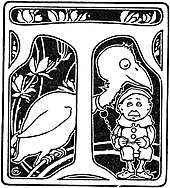A Wild-animal Farm
By Francis Arnold Collins.
 he boy who does the chores on the wild-animal farm stopped pumping, tied the camel to the pump-handle, and hurried over to the kitchen door.
he boy who does the chores on the wild-animal farm stopped pumping, tied the camel to the pump-handle, and hurried over to the kitchen door.“This camel ’s had more than a barrel of water, and he drinks faster than I can pump,” he complained, “and he’s the first of the herd I 've watered.”
The wild-animal farmer appeared in the doorway.
“Well, you see,” said he, good-naturedly, “the critter has eight stomachs, and it takes time to fill ’em up. Anyway, it will last him a week, you know.”
“And the zebras carried away four lengths of fence this morning. We can’t catch ’em, and must wait till they come home for dinner. And we could n’t get the kinks out of the llamas’ coats.”
And he went back to the pump, unloosened the patient old camel, and proceeded to fill up his seventh or eighth stomach.
“Have to de the best you can,” the farmer said. “I ’d sooner farm a thousand cows than that fifty head of camel and dromedaries, let alone the zebras, llamas, and yaks.”
Meanwhile herds of outlandish-looking animals crowd the quaint old farm-buildings on every hand. In the camel-yards half a hundred of these curious ships of the desert lie becalmed. The llamas are craning their long, thin necks nervously through the bars of what was once a cow-shed. Great curly-haired, wide-eyed yaks are munching their fodder in the horse-mangers. The zebras, with their barred coats glistening in the sun, are scattered grazing over the broad meadows.
Come good crops or bad, the wild-animal farm does a thriving business. Its cosmopolitan population, gathered from Asia, Africa, India, from every clime, do not take kindly to farm-work, The camels refuse to plow; no amount of urging will induce the zebras to do the work of horses; nor will the yaks or the sacred cows do the work of ordinary oxen. Actually the farm is a great animal boarding-house, with “boarders” from all over the world. The farm, which comprises some three hundred acres, is located near Allentown, in Pennsylvania. Its population last year numbered more than three hundred “head” of different kinds of stock and comprised a large and fairly complete menagerie.
During the summer months the entire population of the wild-animal farm travels about the country in the vans of the “Greatest Show on Earth.” Early each fall the animals return to their quiet Pennsylvania farm to enjoy a well-earned vacation. It is a great day for the countryside, for miles in all directions, when the circus comes to the country. The great herds of camels, dromedaries, yaks, buffalo, llamas, and the rest, are shipped to the nearest railroad point and paraded across country to their winter quarters, The caravan makes a very pretty picture as it moves slowly along, up hill and down dale, over the quiet country roads.
The winter residents of the wild-animal farm are known in the circus as the “led stock.” In the cross-country march to the farm it might more correctly be called the “pulled, pushed, or hauled stock.” The journey is usually very exciting. In the various parades of the Barnum and Hailey circus throughout the country, these same animals will remain perfectly passive in the streets of -great cities, no matter how loudly the band may play, the calliope whistle, or the small boys shout. But, strange to say, a quiet country lane affects them yery differently, and they will balk as only a camel can, shy at the most innocent bush or tree, crash through high fences or hurdle them, and go flying over the surrounding farms, to the consternation of432
